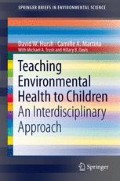Abstract
Lessons on environmental health can be integrated throughout the school curriculum. In chapter one, we first situate the book within the conceptual constructs of the curriculum goals of the National Institute for Environmental Health Sciences (NIEHS) in the United States, which funded developing and implementing the curriculum described. Second, we provide an overview of environmental health along with some of the key themes and concepts that are introduced in the lessons, including environmental agents, toxins and toxicants, dose response, and action strategies that can be taken to reduce exposure risks. Third, we highlight a few of the literally hundreds of lessons developed. Finally, we provide examples of suggested activities in the following chapters that may be adapted for use in schools throughout the world.
Access this chapter
Tax calculation will be finalised at checkout
Purchases are for personal use only
References
AMBIENT (2004). Toxicology— Relating to environment health. Coral Gables FL: University of Miami.
Anto, J.M., Sunyer, J. (1990). Epidemiological studies of asthma epidemics in Barcelona. Chest, November Supplement:185s–189s.
Axelrod, D., Davis, D. L., Hajek, R., & Jones, L. (2001). It’s time to rethink dose: the case for combining cancer and birth and developmental defects. Environmental Health Perspectives, 109(6), A246–A249.
Canfield, R. L., Henderson, C. R, Jr., Cory-Slechta, D. A., Cox, C., Jusko, T. A., & Lanphear, B. P. (2003). Intellectual impairment in children with blood level concentrations below 10ug per deciliter. The New England Journal of Medicine, 348(16), 1517–1526.
Checkly, K. (1997). Problem-based learning: the search for solutions to life’s messy problems. Curriculum Update, 1–3(6–8), 109–113.
Eder, W., Ege, M. J., & Von Mutius, E. (2006). The asthma epidemic. The New England Journal of Medicine, 355(21), 2226–2235.
Haney, J. J. (2004). The Odyssey Design and Implementation Process Project Excite: Taking Action, 2(2), 2–3. Spring.
Kjellstrom, T., & Hick, N. V. (1998). Case X: Atmospheric fog in Greater London. In S. Markowitz (Ed.), Problem Based Training Exercises for Environmental Epidemiology. Geneva, Switzerland: Office of Global and Integrated Environmental Health, World Health Organization.
Lanphear, B. P., Hornung, R., Khoury, J., Yolton, K., Baghursh, P., Bellinger, D. C., et al. (2005). Low-level environmental lead exposure and children’s intellectual function: An international pooled analysis. Environmental Health Perspectives, 113(7), 894–899.
Layton, L. (2009,July31). House approves overhaul of food safety regulations. Washington Post.
Lynch, M. L., Huang, L-A., Cox, C., Strain, J. J., Myers, G. J., Bonham, M. P., Shamlaye, C. F., Stokes-Riner, A., Wallance, J. M. W., Duffy, E. M., Clarkson, T. W., & Davidson, P. W. (2010). Varying coefficient function models to explore interactions between maternal nutritional status and prenatal methylmercury toxicity in the Seychelles Child Development Nutrition Study. Environmental Research http://dx.doi.org/10.1016/j.envres.2010.09.005
Martina, C. A., Hursh, D., & Markowitz, D. G. (2009). Contradictions in educational policy: implementing integrated problem-based curriculum in a high stakes environment. Environmental Education Research, 15(3), 279–297. PMCID: PMC108802.
National Institute of Environmental Health Sciences. (1999). Environmental health science as an integrative context for learning. Washington, D.C: National Institute of Environmental Health Sciences. RAF ES 99–011.
National Research Council. (1996). National science education standards. Washington, D.C.: National Academy Press.
vom Saal, F. S., & Peterson Myers, J. (2008). Bisphenol A and Risk of Metabolic Disorders. Journal of the American Medical Association , 300(11), 1353–1355.
Wines, M. (2009). Lead Sickens 1,300 Children in China, The New York Times, p. A-4.
Author information
Authors and Affiliations
Corresponding author
Rights and permissions
Copyright information
© 2011 David W. Hursh
About this chapter
Cite this chapter
Hursh, D.W., Martina, C.A., Trush, M.A., Davis, H.B. (2011). Environmental Health as an Interdisciplinary Subject. In: Teaching Environmental Health to Children. SpringerBriefs in Environmental Science. Springer, Dordrecht. https://doi.org/10.1007/978-94-007-1811-1_1
Download citation
DOI: https://doi.org/10.1007/978-94-007-1811-1_1
Published:
Publisher Name: Springer, Dordrecht
Print ISBN: 978-94-007-1810-4
Online ISBN: 978-94-007-1811-1
eBook Packages: Earth and Environmental ScienceEarth and Environmental Science (R0)

